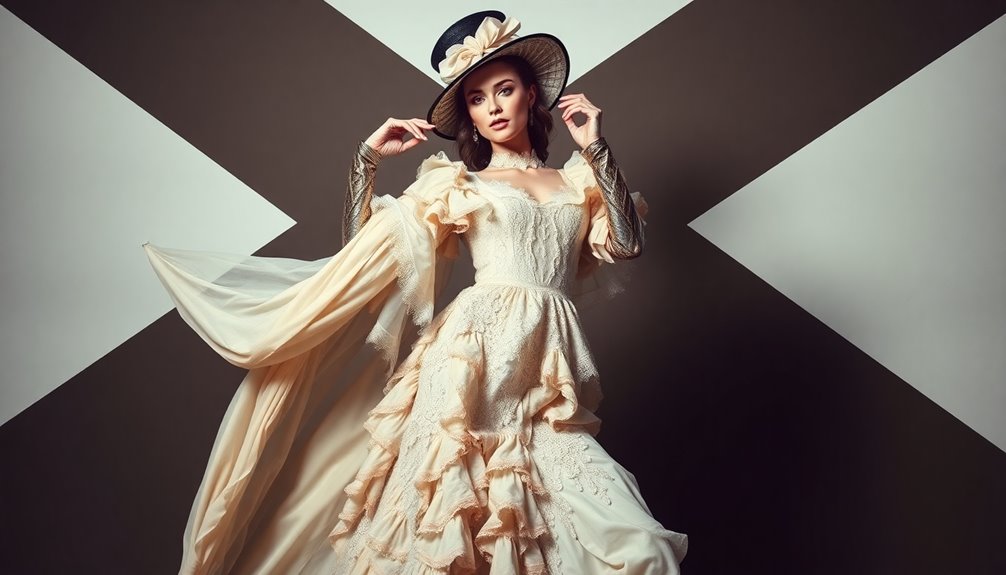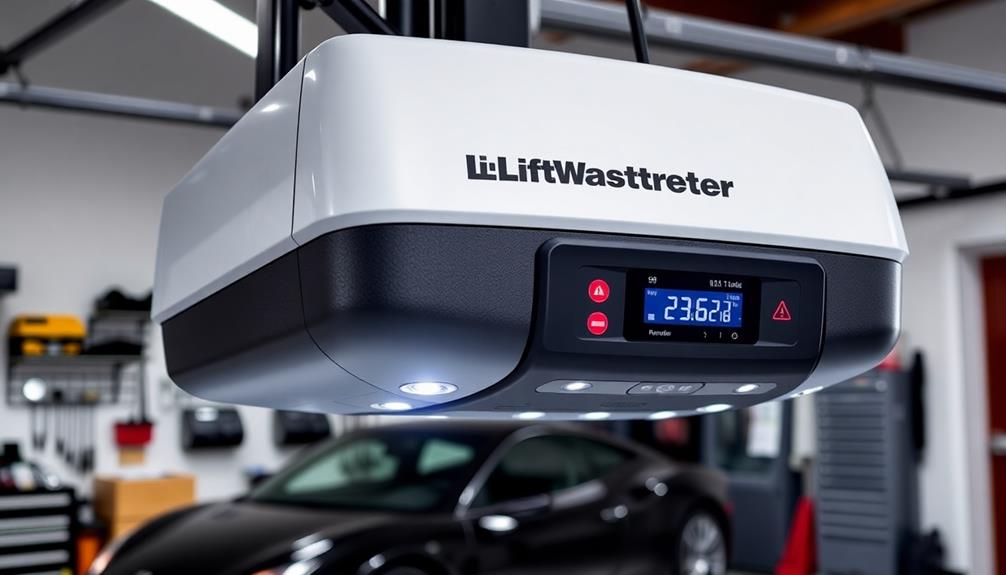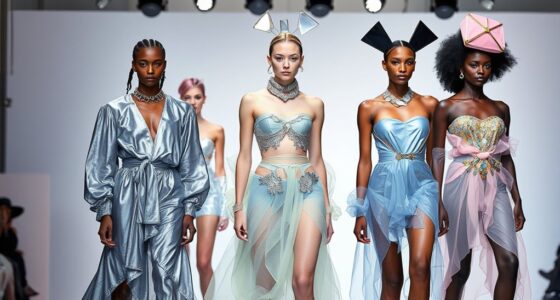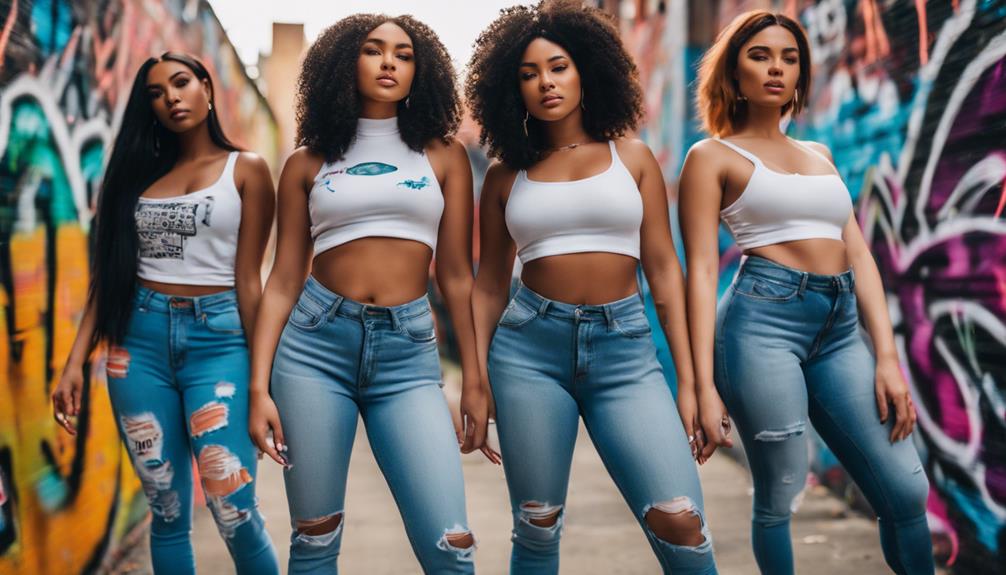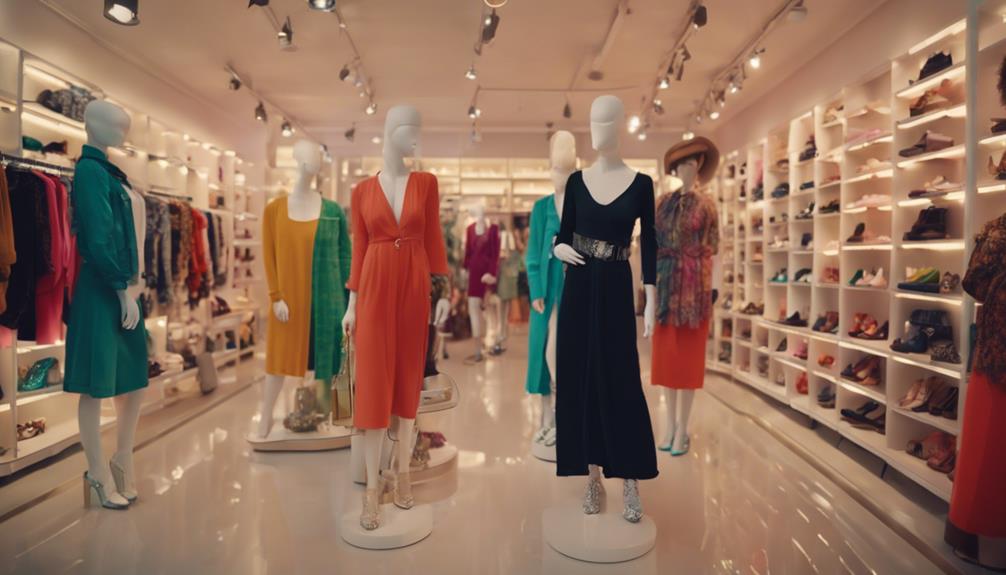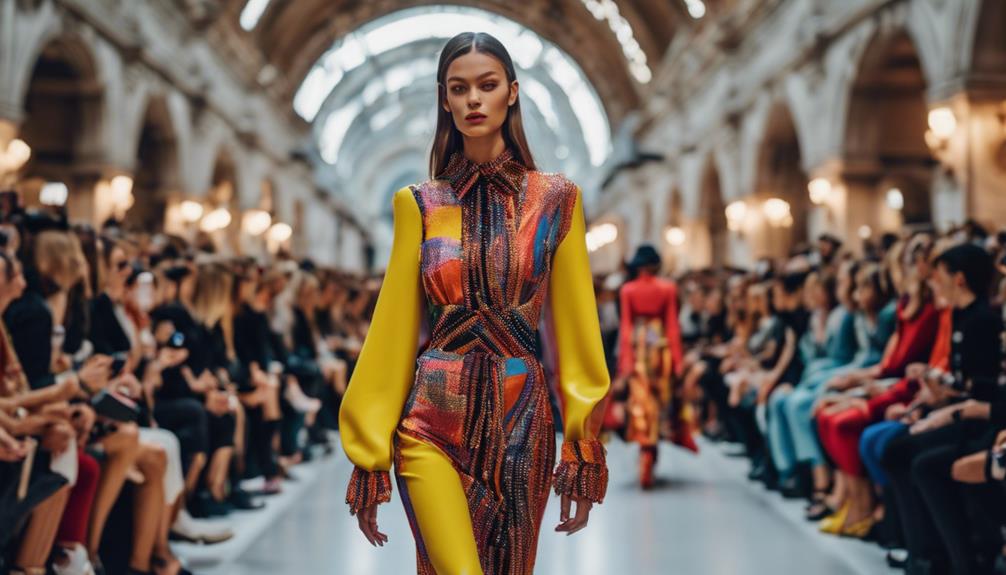Historical fashion elements play a crucial role in shaping modern avant-garde photography. You'll notice timeless aesthetics inspired by iconic movements, from the glam of the Art Deco era to the bold patterns of the 1960s. Contemporary photographers breathe new life into classic designs, creating visually striking narratives that reflect cultural dynamics. Techniques from earlier innovations enhance these works, merging traditional styles with cutting-edge methods. Designers often draw inspiration from avant-garde themes, blending surrealist influences and provocative imagery. Curious to uncover how these elements continue to evolve in the world of fashion photography? There's much more to explore.
Key Takeaways
- Modern avant-garde photography incorporates historical fashion elements like the Little Black Dress, symbolizing timeless versatility and simplicity.
- Surrealist influences from artists like Salvador Dali continue to shape contemporary fashion photography with dream-like imagery and innovative designs.
- The Dada movement's alternative techniques inspire modern photographers to blend unconventional styles with traditional fashion elements, enhancing creative expression.
- Gender fluidity in fashion reflects historical non-gendered garments, promoting inclusivity and challenging traditional norms in contemporary photography.
- Eco-friendly practices and diverse representation in modern avant-garde photography draw from historical luxury fashion, merging sustainability with artistic expression.
Early Influences in Photography
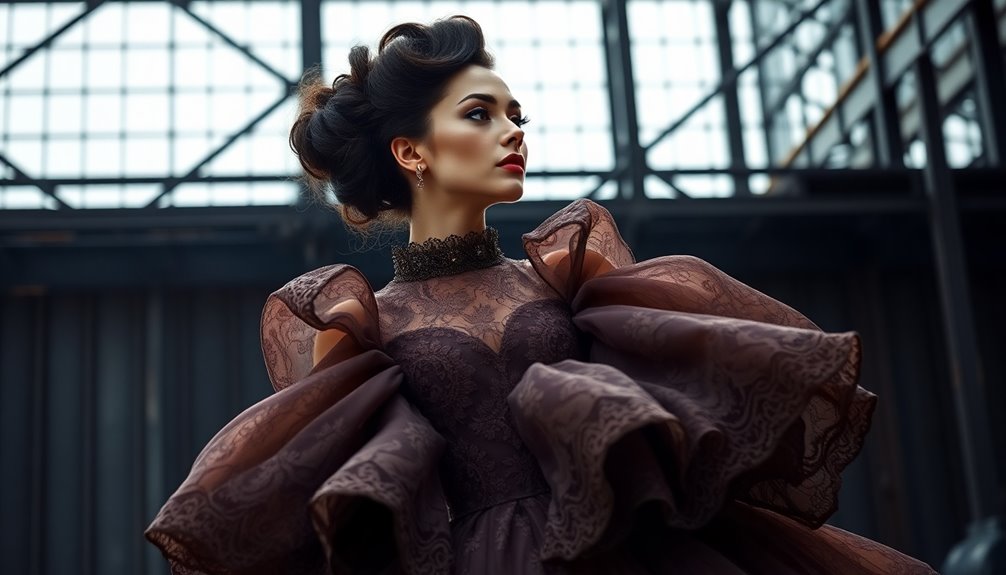
Photography's roots are deeply intertwined with early experimentation and discoveries that paved the way for modern imaging. You can trace these origins back to the Renaissance, where artists used the camera obscura to project images for drawing, blending art with early optics.
In 1717, Johann Heinrich Schulze found that silver salts darken when exposed to light, leading to the creation of fleeting photograms. Fast forward to around 1800, and you'll find Thomas Wedgwood attempting to capture camera images using silver nitrate on paper and leather, though he struggled to fix these images permanently.
The game changed in 1826 when Nicéphore Niépce developed heliography, capturing the first surviving photograph, "View from the Window at Le Gras." This paved the way for Louis Daguerre's daguerreotype process in 1839, which made exposure times shorter and images sharper. The Daguerreotype was a significant leap toward making photography widely accessible.
William Henry Fox Talbot introduced the calotype process in 1841, allowing for multiple copies from a single negative. Each of these innovations laid the groundwork for photography, transforming it from a mere concept into a medium that would evolve dramatically over time.
The Glamour Era's Legacy
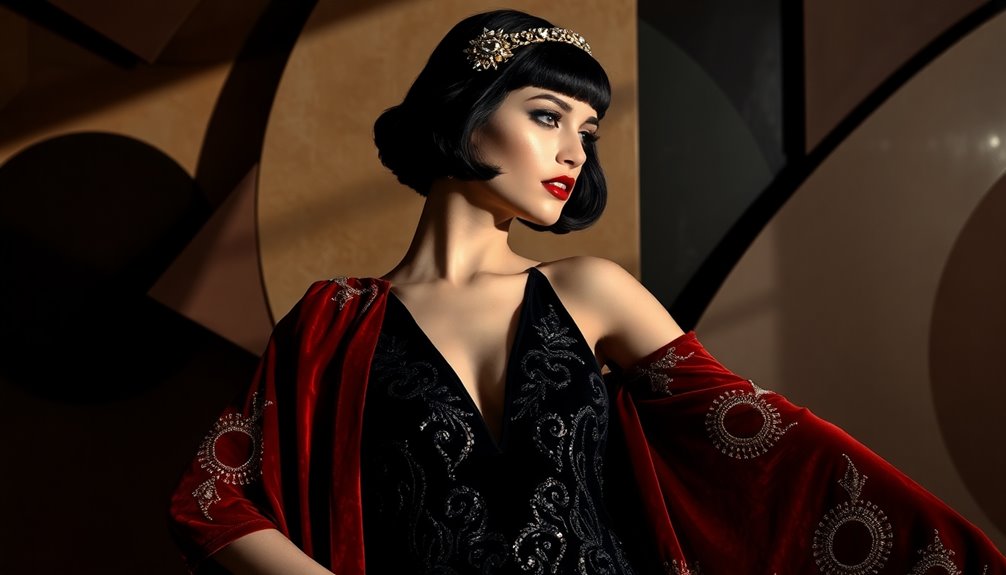
The evolution of photography set the stage for a new era where glamour took center stage, particularly in Hollywood. You can see how George Hurrell's iconic images shaped the public personas of stars, making his photographs more significant than any film. His dramatic use of lighting and close-ups crafted an aura of mystery, elevating these figures to mythic status.
Hurrell's style, characterized by chiaroscuro techniques and high-contrast lighting, sculpted subjects with light and shadow, creating an ethereal quality that captivated audiences. These glamour shots weren't just pretty pictures; they were narratives designed to grab attention. By eliminating imperfections through retouching, Hurrell perfected an idealized version of stardom that resonated deeply with the public. His work established him as MGM's chief portrait photographer, which further solidified his influence in the industry.
The influence of his work helped establish MGM as the "glamour factory" of Hollywood, providing an escape from the harsh realities of life, especially during the Depression. Other photographers followed in his footsteps, yet Hurrell's legacy remains unparalleled. His artistry continues to inspire modern photographers, ensuring that the glamour era's impact endures in today's visual culture, where the allure of celebrity still captivates our imaginations.
Golden Age Innovations
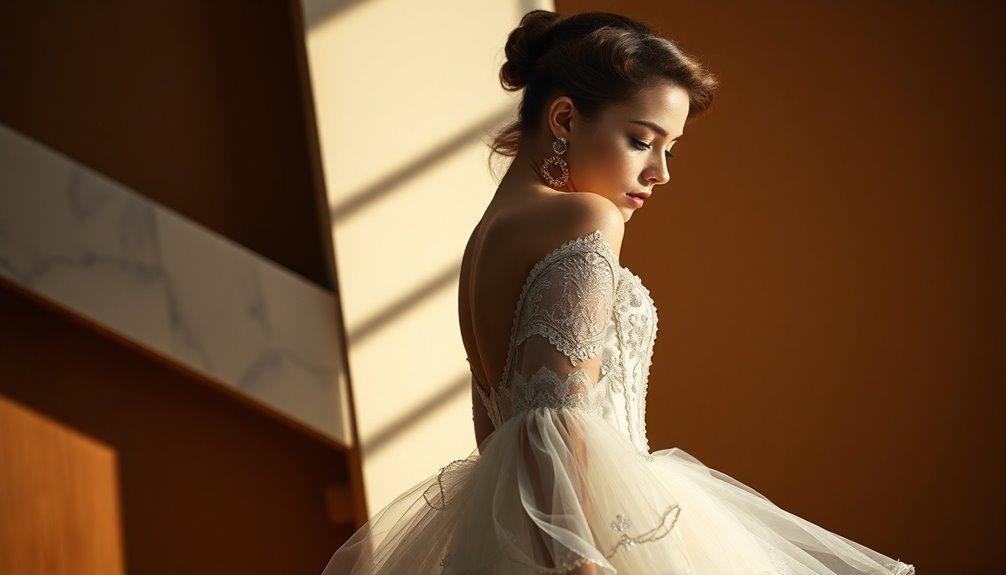
Innovations during the Golden Age of photography transformed the medium into a powerful tool for storytelling and documentation.
You'd notice that the introduction of flexible roll film by Kodak simplified the photographic process, making it accessible for everyone. The development of the 35mm Leica camera further enhanced portability, allowing you to capture moments on the go.
With the invention of flash powder and later flash bulbs, both indoor and outdoor photography became possible, expanding your options for capturing diverse scenes.
Wire-photos revolutionized image transmission, enabling rapid sharing of newsworthy events. The launch of Kodachrome and Ektachrome films brought color to photography, enriching the visual narrative.
In industrial and scientific photography, advances like electric lighting improved conditions for capturing details, while Frank Gilbreth's chronophotography optimized worker movements. This era also saw the rise of industrial photography, which documented the dramatic transformation of factories and labor practices.
Photojournalism blossomed during this era, with iconic figures like Margaret Bourke-White and Dorothea Lange documenting social issues. The founding of Magnum Photos marked a pivotal moment in visual storytelling.
With the Brownie camera, photography became even more accessible, allowing you to engage with the world through your lens. These innovations laid the groundwork for modern photographic practices we see today.
Youth Culture Reflections
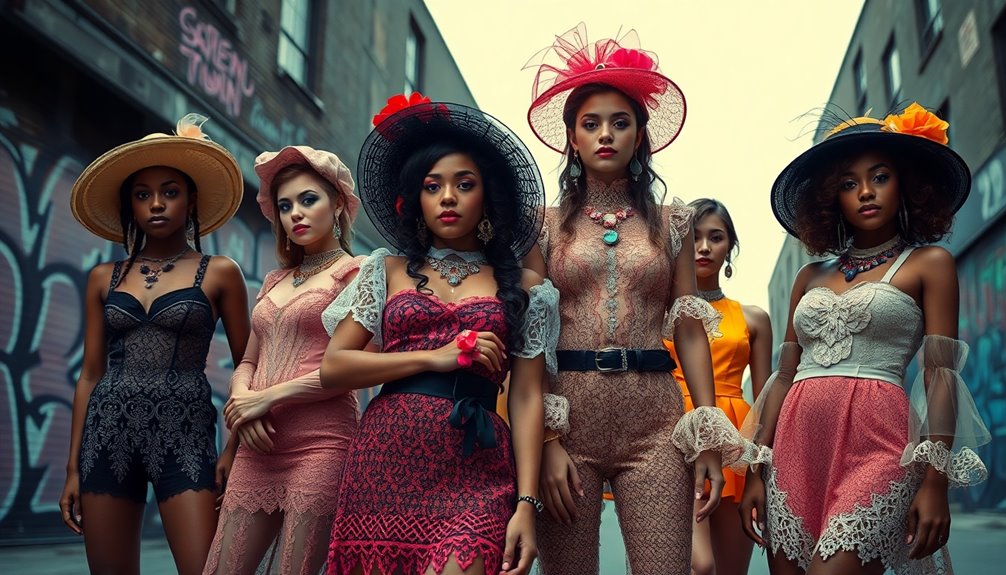
Youth culture in the 20th century became a vibrant canvas for avant-garde photography, reflecting the evolving social landscapes and attitudes of the time. The interwar period saw photographers like John Heartfield, who used photomontage to critique political and societal norms, capturing the essence of youth disillusionment amidst chaos.
This radical spirit, influenced by the Dada movement, encouraged a break from tradition, pushing the boundaries of photographic techniques and challenging viewers to rethink their perceptions.
As you explore the 1960s and 1970s, you'll notice how artists from the Arte Povera movement embraced conceptual photography. By documenting ephemeral performances, they expanded photography's role beyond mere image capture, offering a multidimensional experience that resonated with youthful rebellion and experimentation. In contemporary practices, artists often blend historical processes with modern techniques, reflecting a nuanced understanding of identity and culture. This fusion allows you to witness how today's youth engage with their heritage, making statements about self-worth and personal narratives.
For instance, the exhibition "Picturing the Avant-Garde" showcases alternative photographic techniques that expand the interpretation of photographic imagery, illustrating the ongoing dialogue between history and contemporary artistic expression.
Ultimately, avant-garde photography serves as a powerful mirror for youth culture, capturing its essence through provocative and innovative means.
Provocative Themes in Fashion
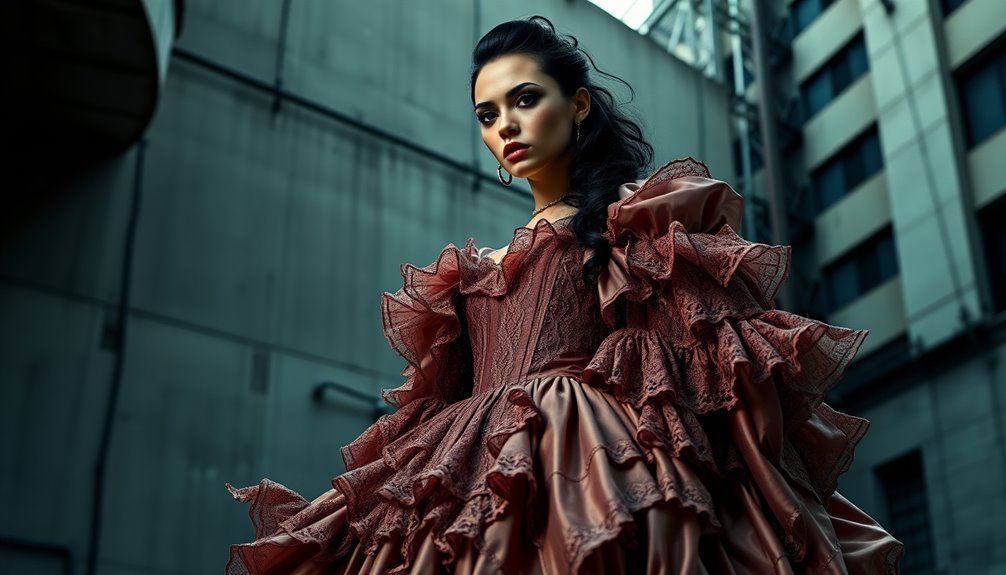
Provocative themes in fashion have continually pushed boundaries, challenging societal norms and perceptions of beauty. You'll see this vividly through the influence of Art Deco, where fashion photography embraced opulent designs with sleek lines and luxurious materials.
The sharp focus and strategic lighting highlighted intricate patterns, reflecting a society fixated on glamour and social status. The era of Golden Age of fashion photography brought forth iconic images that defined modern aesthetics.
Hollywood glamour also played a significant role, elevating fashion photography to an art form. Iconic figures like Josephine Baker and Marlene Dietrich graced the lens, their dramatic poses and exquisite lighting capturing the essence of allure and sophistication.
On the other hand, S&M glamour introduced a provocative edge, delving into themes of fetishism and sexuality. This bold approach challenged conventional beauty standards, embracing dominance and submission while presenting edgy imagery that sparked conversation.
In recent years, contemporary trends have shifted focus towards street style and realism. This evolution responds to the economic climate and cultural movements, incorporating gritty aesthetics and minimalist elegance.
You'll witness a blend of high-end designs with street fashion, revealing how provocative themes in fashion continue to inspire and provoke thought.
Surrealism's Impact on Style
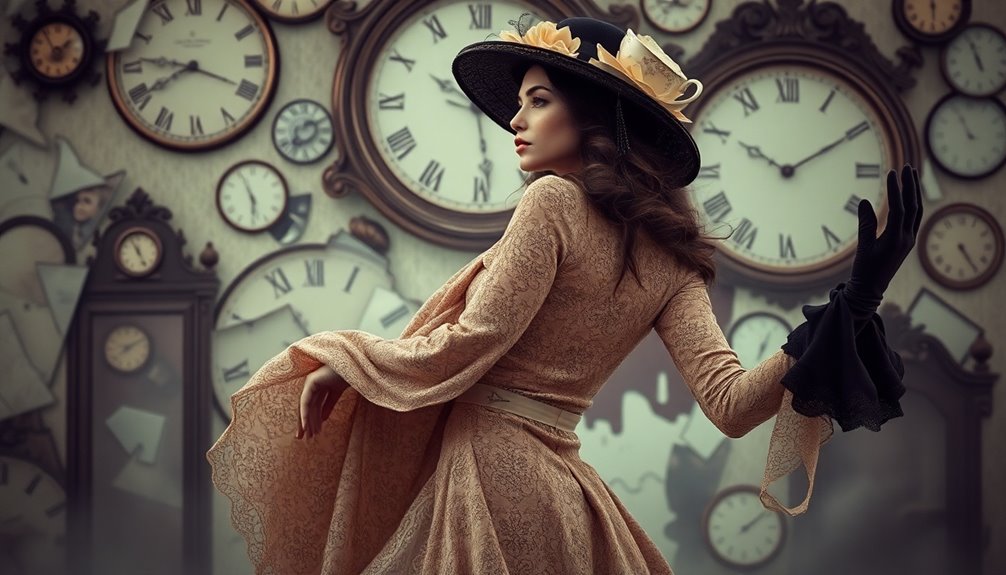
Surrealism has profoundly shaped modern fashion, intertwining art and style in ways that challenge conventional aesthetics. Emerging in the 1920s, surrealism's influence reached fashion through iconic figures like Salvador Dali, René Magritte, and Elsa Schiaparelli. Their groundbreaking collaborations, such as the Lobster Dress and the Shoe Hat, transformed clothing into captivating art pieces, pushing the boundaries of what fashion could represent.
In fashion photography, surrealism introduces dream-like imagery that blurs the line between reality and fantasy. You'll notice unusual combinations and elements that evoke emotion and invite interpretation. Ethereal editorials combine high fashion with surreal aesthetics, creating otherworldly visuals that captivate viewers. These images often incorporate unexpected visual twists, encouraging a deeper engagement and questioning of perception. The focus on the subconscious within surrealism enables artists to challenge traditional fashion norms and push creative boundaries. Additionally, the rise of AI integration in creative fields has opened new avenues for artists to explore surrealistic concepts in their work.
Today, contemporary designers like Alexander McQueen and Iris van Herpen continue this legacy, crafting boundary-pushing pieces that reflect surrealist principles. Fashion shows have evolved into elaborate dreamscapes, merging reality with fantasy.
Even everyday fashion incorporates surreal elements, from unconventional materials to unexpected cutouts. This enduring influence ensures that surrealism remains a vital force in the ever-evolving landscape of style.
Contemporary Avant-Garde Trends
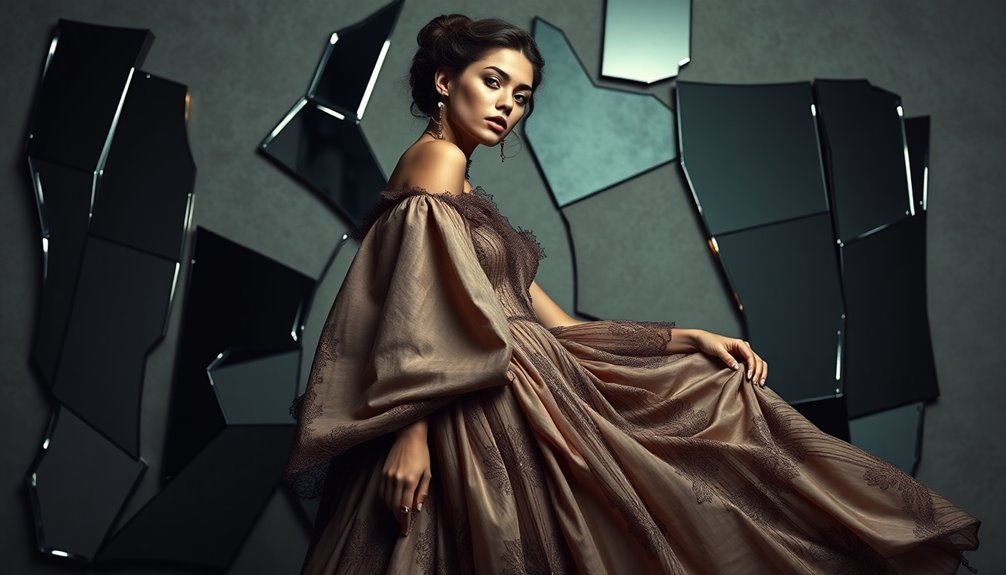
In today's fashion photography landscape, countless contemporary avant-garde trends are reshaping how designers and photographers express their visions. You'll find that experimental techniques, like incorporating unconventional lighting and mixing analog with digital elements, create a unique aesthetic that feels both nostalgic and futuristic. Additionally, incorporating predictive analytics into marketing strategies can help photographers understand audience preferences and tailor their work accordingly.
Encouraging models to play with dynamic postures injects authenticity and energy into your photos, while in-camera manipulations, such as photomontages and unusual angles, challenge conventional perspectives.
Unconventional props and settings also elevate visual storytelling. By integrating avant-garde sculptures or everyday objects, you craft surreal environments that provoke thought. Bold colors and metallic textures combined with neon lighting push boundaries, making your imagery striking and memorable.
Advanced technology, particularly AI, simplifies your workflow. From automatically retouching skin to enhancing image quality, these tools allow you to focus more on creativity. You can even blend traditional processes with modern digital techniques for innovative results, as AI advancements streamline tasks and enhance image quality.
Lastly, exploring innovative angles, like Dutch tilts or extreme viewpoints, adds dynamism to your work. Experimentation with motion and mirrors further enriches your visual narrative, offering fresh perspectives that captivate your audience.
Cultural Context and Identity
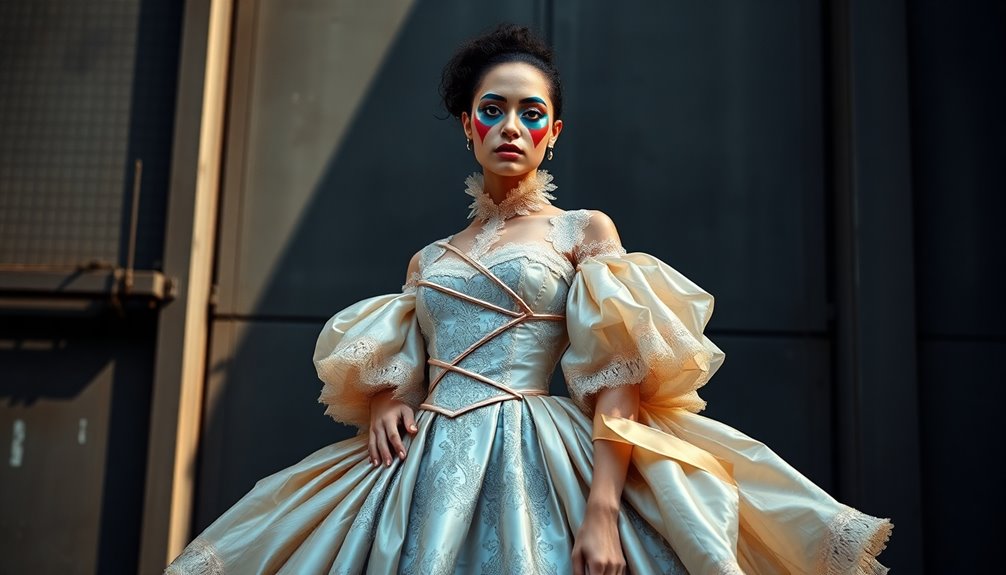
Fashion photography not only showcases garments but also acts as a mirror reflecting cultural contexts and identities. In the early 20th century, it highlighted luxury and social status, emphasizing elegance through shimmering silks and rich brocade.
The Art Deco movement introduced geometric designs and luxurious fabrics, showcasing the interplay of light and shadow. Hollywood's glamour further influenced this medium, with dramatic poses and exquisite settings that captivated audiences. This era also saw the rise of commercial grade heat pumps, which became essential for maintaining consistent indoor temperatures in elaborate fashion studios.
As society evolved, so did fashion photography. The post-war era brought a resurgence of couture, with iconic designers like Christian Dior and photographers such as Irving Penn shaping the narrative. Modern trends in fashion photography emphasize authenticity and storytelling, showcasing how narratives can elevate the visual impact of fashion.
The 1960s and 1970s marked a pivotal shift, embracing cultural movements like youth culture and women's liberation, introducing diverse models and challenging traditional beauty standards.
This evolution also reflected broader identity themes, such as the androgynous aesthetics that emerged, breaking away from rigid gender norms.
As fashion photography increasingly integrated global influences, it celebrated street style and everyday fashion trends, making a powerful statement about identity and cultural diversity. This evolution in aesthetics highlighted the importance of personal expression and the unique stories behind each outfit. One notable example is the significant Japanese street fashion impact on photography, which introduced bold colors, eclectic layering, and a distinct mix of traditional and contemporary styles. As photographers began to embrace these global trends, they not only captured the vibrant essence of everyday life but also emphasized the rich tapestry of cultures intersecting through fashion.
In this way, fashion photography remains a vital tool for exploring and expressing the complexities of cultural identity today.
Gender Fluidity in Fashion
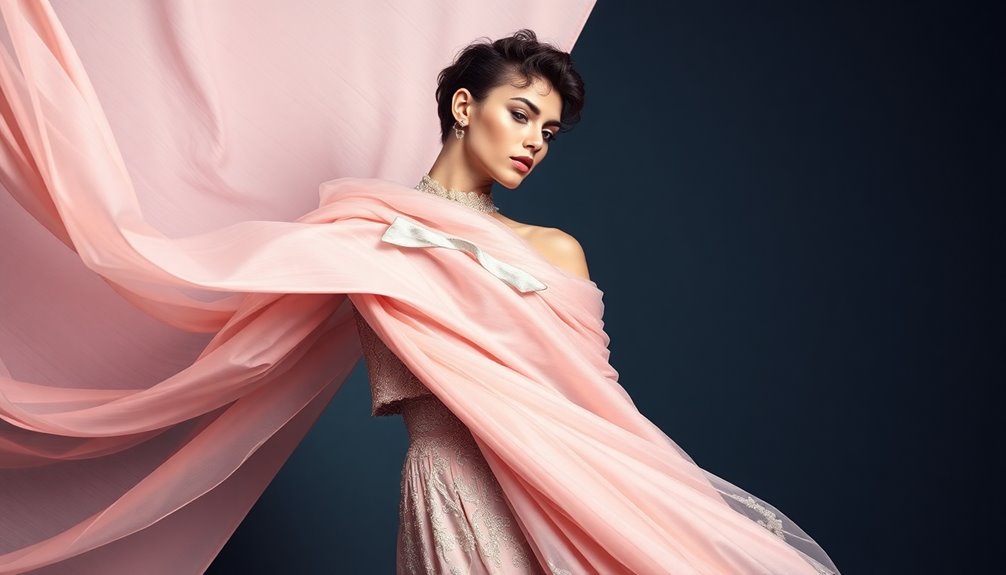
Historically, gender fluidity in fashion has often challenged societal norms, reshaping how people perceive clothing and identity. Ancient civilizations embraced non-gendered garments like togas and tunics, while feudal times favored status over gender in attire.
The Renaissance further blurred these lines, showcasing men in lace and luxurious capes. Fast forward to the 20th century, and figures like Yves Saint Laurent revolutionized women's fashion with his 'Le Smoking' suit, breaking traditional barriers.
Musicians like Jimi Hendrix and David Bowie popularized androgynous styles, paving the way for the grunge movement in the 1990s, where men and women alike wore combat boots and flannel shirts. Modern gender-fluid collections today offer suits, denim jackets, and sneakers that defy gender classification, allowing you to express your identity freely. Brands like Gucci champion unisex collections, making gender fluidity more mainstream than ever.
As Gen Z increasingly shops outside their assigned categories, the British Fashion Council's decision to unify London Fashion Week reflects this shift.
Celebrities continue to challenge norms, and everyday individuals contribute to this evolving dialogue on self-expression and identity. Fashion isn't just about clothes; it's about redefining who we are.
Photography Techniques Evolution
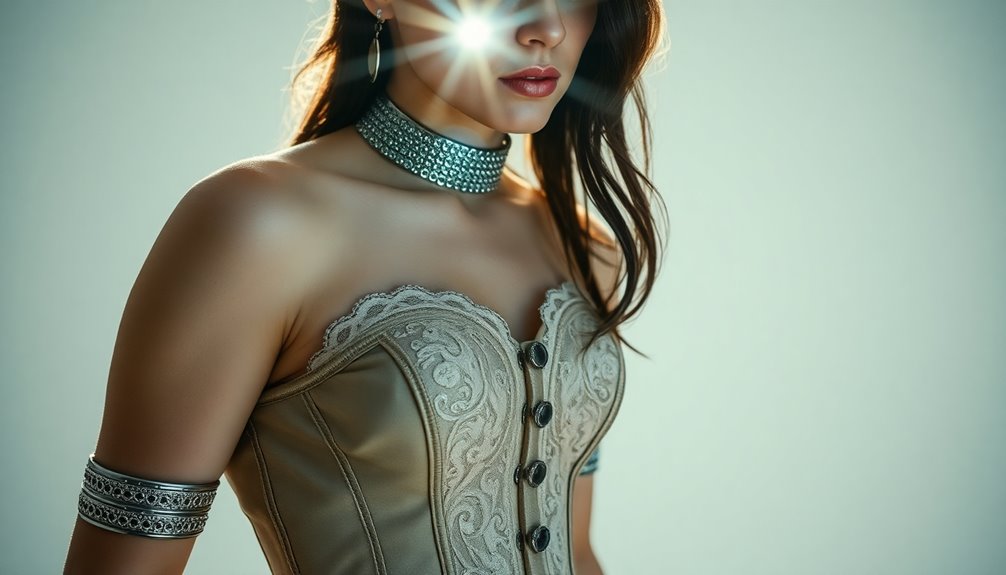
The evolution of photography techniques has transformed how we capture and interpret the world around us. From the early days of the camera obscura, dating back to the 5th century BCE, you can see the progression in methods that have shaped modern photography. The introduction of the pinhole camera in the 11th century marked the beginning of image projection, leading to the first permanent photograph created by Joseph Nicéphore Niépce in 1826.
As you explore the development of photographic processes, innovations like the daguerreotype and calotype stand out. The daguerreotype, invented in 1839, allowed for stunning detail, while the calotype introduced a negative-to-positive process that paved the way for modern photography. Notably, the daguerreotype was the first practical photographic process, marking a significant advancement in the history of photography.
By the late 1800s, mechanical shutters and hand-held cameras made photography more accessible.
The digital era further revolutionized this art form, with the first digital camera invented in 1975. Commercial digital cameras from the 1990s and smartphone cameras have changed how you capture moments, allowing instant sharing and publication.
Today's advanced image sensors and editing software enhance the quality of your photographs, making it easier than ever to express your vision.
Iconic Fashion Movements
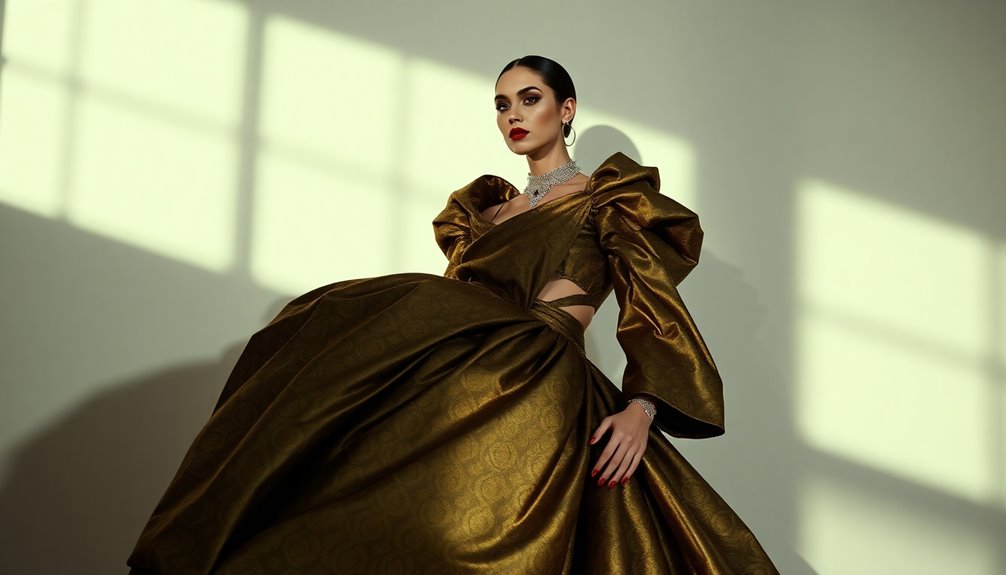
Iconic fashion movements have shaped the way we express ourselves through clothing, reflecting societal changes and cultural shifts.
Think about Paul Poiret, who liberated women from the confines of corsets and introduced innovative styles like hobble skirts and harem pantaloons. His pioneering draping techniques set the stage for modern design, while his 1914 designer tour laid the groundwork for contemporary fashion shows.
Then there's Coco Chanel, whose 1926 introduction of the Little Black Dress changed the fashion landscape. By normalizing black as a versatile color, she promoted simplicity and comfort, creating timeless pieces that redefined women's fashion. Chanel's designs emphasized the importance of egalitarian fashion principles.
Her influence didn't stop there; in the 1950s, she reintroduced her signature slim silhouette, further shaping the American look.
Christian Dior's 1947 "New Look" marked a return to femininity post-WWII with cinched waists and full skirts, challenging wartime rationing with luxurious fabrics.
The 1960s brought a revolution, with miniskirts and bold patterns symbolizing liberation and empowerment. Designers like Mary Quant and André Courrèges embraced vibrant colors and innovative materials, reflecting a society eager for change.
Each movement leaves a lasting imprint on modern fashion, inspiring contemporary creativity.
The Role of Digital Media
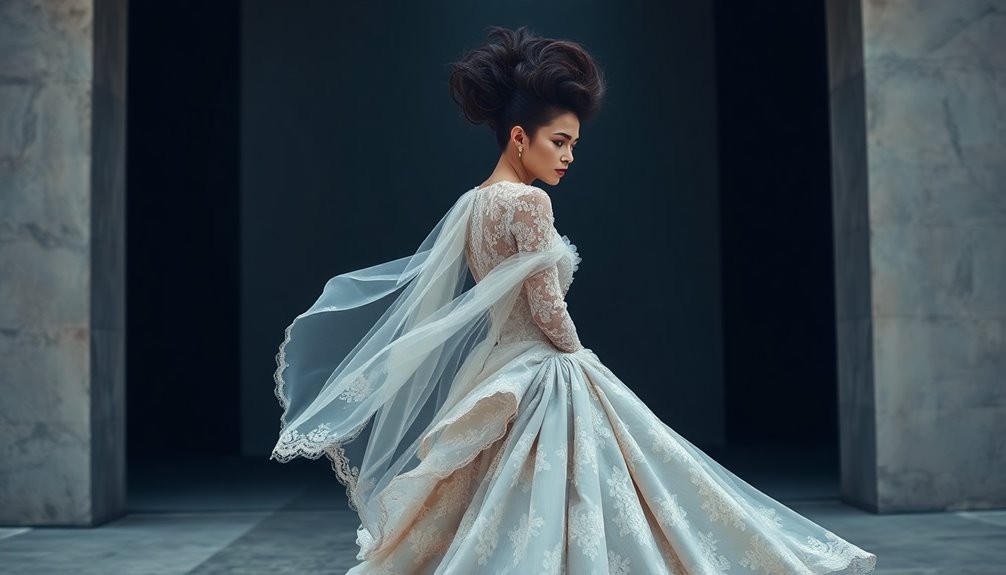
Digital media has revolutionized the landscape of photography, offering artists unprecedented tools to express their creativity. You can now utilize advanced software like Photoshop to manipulate images, creating stunning montages and collages without even needing a camera.
Techniques such as Neural Style Transfer and Ebsynth allow you to blend photos and videos, producing unique stylized outputs that push the boundaries of visual art. As a result of the rise of avant-garde photography, digital landscapes become your canvas, letting you capture artistic photographs in virtual environments. You can continuously change perspectives and create dynamic, animated experiences, showcasing your innovative vision.
Digital media also encourages experimentation with taboo subjects and unconventional methods, enabling you to fuse vibrant colors with video footage for dreamlike results. This cultural transformation ensures that avant-garde photography remains accessible, thanks to affordable tools and apps. Plus, the digital art movement gains recognition and legitimacy through platforms like NFTs, broadening your opportunities to share and exhibit your work.
Ultimately, digital media empowers you to connect, innovate, and redefine what avant-garde photography can be, all while engaging with vibrant online communities.
Future Directions in Fashion Photography
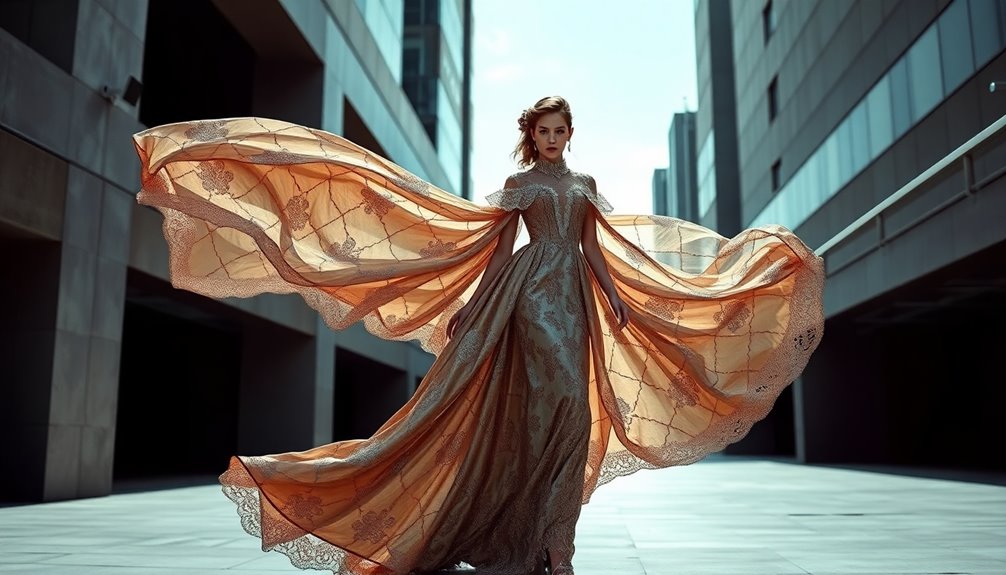
As fashion photography evolves, it's crucial to embrace emerging trends that reflect societal shifts and consumer values.
You'll notice a significant emphasis on sustainability and ethical practices in the industry. Photographers are increasingly exploring eco-friendly shooting locations and using recycled materials for sets and props, minimizing waste to align with environmental preservation. This approach not only enhances visual storytelling but also conveys a brand's commitment to the planet. The use of sustainable printing methods is becoming integral to the production process, further reducing the environmental footprint. Additionally, the incorporation of renewable energy solutions into production setups can further enhance the sustainability of fashion shoots.
Moreover, diversity and inclusivity are becoming central themes. You'll see a wider range of body types and ethnicities in campaigns, challenging traditional beauty standards and promoting empowerment. Celebrating uniqueness, including nudity, fosters a sense of togetherness in fashion.
Innovative lighting and composition will also shape future photography. Expect experimentation with colored gels, unique setups, and even augmented reality to create immersive experiences.
Cinematic storytelling is on the rise, focusing on narratives that evoke emotions. Collaborations among photographers, models, and stylists will lead to innovative visuals that tell personal stories.
Frequently Asked Questions
How Do Historical Fashion Elements Influence Modern Avant-Garde Photographers Today?
Historical fashion elements shape your perspective as a modern avant-garde photographer. You incorporate styles and techniques from past movements, blending them with contemporary concepts to create striking visuals that challenge norms and inspire fresh narratives.
What Role Do Fashion Designers Play in Contemporary Avant-Garde Photography?
Fashion designers shape contemporary avant-garde photography by defining visual narratives and thematic elements. They collaborate closely with photographers, pushing creative boundaries and inspiring new artistic expressions, ensuring that each photoshoot captures their unique vision and aesthetic.
How Has the Audience's Perception of Fashion Photography Evolved Over Time?
You've seen fashion photography transform from mere image-making to a powerful narrative art form. As society evolves, you appreciate deeper meanings, diverse representations, and the fusion of cultural influences that challenge traditional beauty standards and perceptions.
What Are the Ethical Considerations in Using Historical Fashion References?
When using historical fashion references, you've got to respect the original context, avoid stereotypes, and ensure diverse representation. Always credit creators and be transparent about your inspirations to maintain authenticity and ethical standards.
How Do Modern Avant-Garde Photographers Source Inspiration From Historical Fashion?
Modern avant-garde photographers source inspiration from historical fashion by exploring vintage aesthetics, reinterpreting iconic designs, and blending cultural influences. You'll notice how these elements create innovative visuals that challenge traditional norms and provoke thought.
Conclusion
In exploring the intersection of historical fashion elements and modern avant-garde photography, you can see how past influences shape today's visual narratives. From the glamour of earlier eras to the bold innovations of youth culture, each style leaves an indelible mark. As digital media evolves, it redefines how you experience and interpret fashion photography. Embracing these connections not only enriches your understanding but also inspires future creativity in this ever-evolving art form.
